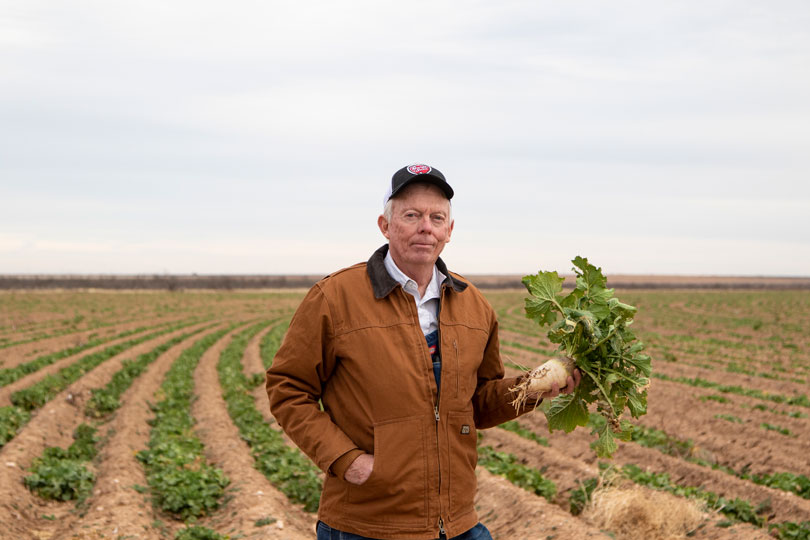By Jennifer Dorsett
Field Editor
Like the sun coming up each morning or the stars shining at night, wind is just another fact of life on the High Plains. But losing topsoil to those West Texas winds doesn’t have to be just another fact. Lynn County dryland cotton farmer Jack Scott is doing his best to keep his topsoil firmly in place with a little help from a cover crop—turnips.
“The turnips are making an excellent cover crop for me,” Scott said. “I don’t have to borrow money to go in and pitch up beds or take care of the sand to keep it from blowing. I want healthy topsoil, not a desert.”
Scott had the idea to plant turnips in his cotton fields about 35 years ago. His younger brother rotated cotton with turnips that year as a production agriculture crop, and Scott noticed something.
The cotton his brother planted after the turnips were harvested was some of the best-looking cotton he’d ever seen. So he started experimenting with the root vegetable as a cover crop.
This year, he’s taking it one step further. He plans to leave the turnips in place and plant cotton right on top. The cotton roots will grow directly down through the tuberous vegetables and “cannibalize” the turnips for nutrients.
The turnip roots will have also broken up the hard pan, creating a path for cotton roots to grow deeper below the surface and resist being blown away in a windstorm.
“Come summertime, when it gets hot and the cotton gets dry, it might start trying to shed off its squares and bolls,” Scott said. “That’s where the turnips come in handy, because turnips contain potassium. And potassium is what the cotton has to have to make it hold out, keep the squares and the blooms still going.”
He made the risky decision in 2018 to skip planting cotton. The year started off dry, and wind was blowing dirt from fields faster than farmers could keep up sandfighting.
“If I had planted cotton, then the insurance rules would have me tending to a dying stand most of the year, if it didn’t end up blowing away,” Scott said. “Then, to collect the insurance, well…I’d have to plow it under and have even more soil erosion.”
So instead, in late June, he listed up the ground. He said he caught a little rain in August, pitched the beds even higher and planted turnips in the furrows.
“Planting turnips is really simple, and it’s cheap. You can get by with about two pounds to the acre,” he said. “So for a seed cost of about $5 an acre, all I had to do was just dribble the seed out in the furrow and pray for rain. And I got it.”
The last time Scott planted turnips about 25 years ago, he said the leaves on his cotton crop were as big as elephant ears. But a bad hailstorm knocked the crop completely flat, so he didn’t make it to harvest.
He’s hopeful 2019 is the year his experiment with turnips finally yields a bountiful harvest.
Conservation techniques like cover crops, crop rotation, no-till and minimum-till have their place in keeping farmers in business, according to Scott. The benefits far outweigh the additional work and costs associated with those practices.
Scott has rotated crops and planted cover on one of his farms for 40 years. Before that, it was in continuous row crop production. He said it had washes and areas where the soil would blow away easily. But since he’s been rotating crops and planting cover crops, he’s seen the washes heal over, and he said even the lake beds don’t hold water now.
“I’ll have my neighbors asking me, ‘How come you don’t have lakes out there after it rains?’” he said. How come you’re out there before we’re even running a sandfighter?’ And it’s the conservation. You don’t see it, because it’s so gradual, but it’s paying off. At least, for me, it is.”


What a fabulous idea………thought about blackeyed peas in the same way but this is even greater! Thanks for sharing. Wish I could roll back time and use this practice when I was farming. People, pay attention, wisdom sometimes whisper and we should all listen.